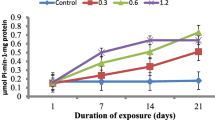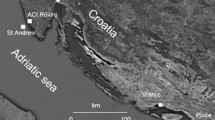Abstract
Gobionellus oceanicus is a species widely distributed on the Atlantic coast and may be susceptible to anthropic effects. This study evaluated the morphology and the Na+/K+-ATPase activity of G. oceanicus gills considering the concentration of metals in the fish and Subaé River estuary. Although the metal concentrations detected in the water and sediment did not exceed certain limits, CONAMA (Brazilian Environment Council), TEL (Threshold Effect Level), and PEL (Probable Effect Level), the metals levels in gills plus muscle and skin of G. oceanicus were above the permitted setting of the Ministry of Health, Brazil. The pavement epithelial cells (PVC) of the gill filament was observed that there were long microridges either in the apical surface or in the lamella; especially, microridges degeneration was shown in some PVC from filament epithelium. The number of ionocyte and the volume density were (0.02 ± 0.001)/μm and (0.38 ± 0.27) %, respectively. The activity of Na+/K+-ATPase was 1.13 ± 0.76 μM Pi mg protein−1 h−1. We describe the volume density and number of ionocytes and Na+/K+-ATPase enzymatic activity in G. oceanicus for the first time, which is useful for basic and comparative future studies to support aquatic biomonitoring.



Similar content being viewed by others
References
Andrade-Tubino MF, Ribeiro ALR, Vianna M (2008) Organização espaço-temporal das ictiocenoses demersais nos ecossistemas estuarinos brasileiros: uma síntese. Oecol Bras 12(4):640–661
Bradford MM (1976) A rapid and sensitive method for the quantification of microgram quantities of protein utilizing the principle of protein-dye binding. Anal Biochem 72:248–254
Brazil. SVS/MS - Ministério da Saúde. Secretaria de Vigilância Sanitária (1998) “Princípios Gerais para o Estabelecimento de Níveis Máximos de Contaminantes Químicos em Alimentos”. Portaria no. 685, de 27 de agosto de 1998. D.O.U. – Diário Oficial da União; Poder Executivo, de 28 de agosto de 1998
Brunelli E, Talarico E, Corapi B, Perrotta I, Tripepi S (2008) Effects of a sublethal concentration of sodium lauryl sulphate on the morphology and Na+/K+ ATPase activity in the gill of the ornate wrasse (Thalassoma pavo). Ecotoxicol Environ Saf 71:436–445. https://doi.org/10.1016/j.ecoenv.2007.09.010
Burton TD, Jones AH, Cairns Jr J (1972) Acute zinc toxicity to rainbow trout (Salmo gairdneri): confirmation of the hypothesis that death is related to tissue hipoxia. J Fish Res Board Can 29:1463–1466
Bury NR, Boyle D, Cooper CA (2001) Iron. In: Wood CM, Farrell AP, Brauner CJ (eds) Homeostase and toxicology of essential metals. 1st edn. Academic Press, New Cambridge, pp 201–251
Camargo MMP, Fernandes MN, Martinez CBR (2009) How aluminium exposure promotes osmoregulatory disturbances in the neotropical freshwater fish Prochilus lineatus. Aquat Toxicol 94:40–46. https://doi.org/10.1016/j.aquatox.2009.05.017
Canadian Council of Ministers of the Environment (2002) Canadian sediment quality guidelines for the protection of aquatic life: Summary tables. Canadian environmental quality guidelines, Winnipeg
Conama. Conselho Nacional do Meio Ambiente/Ministério do Meio Ambiente (2005) Resolução No. 357 de 17 de março de 2005 http://www.mma.gov.br/port/conama/legiano1.cfm?codlegitipo=3&ano=2005. Accessed 13 Aug 2005
Costa OTF, Pedretti AC, Schmitz A, Perry SF, Fernandes MN (2007) Stereological estimation of surface area and barrier thickness of fish gills in vertical sections. J Microsc 225(1):1–9. https://doi.org/10.1111/j.1365-2818.2007.01710.x
Dang Z, Lock RAC, Flick G, Wendelaar Bonga SE (2000) Na+/K+-ATPase immunoreactivity in branchial chloride cells of Oreochromis mossambicus exposed to cooper. J Exp Biol 151:517–428
Dirilgen N (2001) Accumulation of heavy metals in freshwater organisms: assessment of toxic interactions. Turk J Chem 25:173–179
Eisler R, Gardner GR (1973) Acute toxicology to an estuarine teleost of mixture of cadmium, copper and zinc salts. J Fish Biol 5:131–142
Eschmeyer, WN, Fricke R, van der Laan R (eds) (2017) Catalog of fishes: genera, species, references. [This version was edited by Bill Eschmeyer.] [Electronic version]. [cited 2017 Jun 23]. Available from: http://researcharchive.calacademy.org/research/ichthyology/catalog/fishcatmain.asp
Evans DH (1987) The fish gill: site of action and model for toxic effects of environmental pollutants. Environ Health Persp 71:47–58
Evans DH, Piermarini PM, Potts WTW (1999) Ionic transport in the fish gill epithelium. J Exp Zool 283:641–652
Evans DH, Piermarini PM, Keith PC (2005) The multifunctional fish gill: dominant site of gas exchange, osmoregulation, acid-base regulation, and excretion of nitrogenous waste. Physiol Rev 85:97–177. https://doi.org/10.1152/physrev.00050.2003
Fernandes MN, Paulino MG, Sakuragui MM, Ramos CA, Pereira CDS, Sadauskas-Henrique H (2013) Organochlorines and metals induce changes in the mitochondris-rich cells of fish gills: an integrative field study involving chemical, biochemical and morphological analyses. Aquat Toxicol 126:180–190. https://doi.org/10.1016/j.aquatox.2012.11.008
Guite LL, Paul R, Ramanujam SNI (2015) Scanning electron microscopic studies on the gills of the catfish Heteropneustes fossilis (Bloch) exposed to copper at varying pH. Bull Environ Contam Toxicol 94:709–714. https://doi.org/10.1007/s00128-014-1455-7
Geffard O, Geffard A, His E, Budzinski H (2003) Assessment of the bioavailability and toxicity of sediment-associated polycyclic aromatic hydrocarbons and heavy metals applied to Crassostrea gigas embryos and larvae. Mar Pollut Bull 46:481–490. https://doi.org/10.1016/S0025-326X(02)00451-4
Hatje V, Barros FCR, Figueiredo DG, Santos VLCS (2006) Trace metal contamination and benthic assemblages in Subaé estuarine system, Brazil. Mar Pollut Bull 52:969–977. https://doi.org/10.1016/j.marpolbul.2006.04.016
Hatje V, Bícego MC, Carvalho GC, Andrade JB (2009) Contaminação química. In: Hatje V, Andrade JB (eds) Baía de Todos os Santos: aspectos oceanográficos. Edufba, Salvador, pp 243–299
Hatje V, Macedo SM, Jesus RM, Garcia K, Queiroz AF (2010) Inorganic as speciation and bioavailability in estuarine sediments of Todos os Santos Bay, BA, Brazil. Mar Pollut Bull 60:2225–2232. https://doi.org/10.1016/j.marpolbul.2010.08.014
Hatje V, Barros F (2012) Overview of the 20th century impact of trace metal contamination in the estuaries of Todos os Santos Bay: past, present and future scenarios. Mar Pollut Bull 64:2603–2614. https://doi.org/10.1016/j.marpolbul.2012.07.009
Hernández RB, Farina M, Esposito BP, Souza-Pinto NC, Barbosa F, Sunol C (2011) Mechanisms of manganese-induced neurotoxicity in primary neuronal cultures: the role of manganese speciation and cell type. Toxicol Sci 124:414–423. https://doi.org/10.1093/toxsci/kfr234
Hiroi J, McCormick SD (2012) New insights into gill ionocyte and ion transporter function in euryhaline and diadromous fish. Respir Physiol Neurobiol 184(3):257–268. https://doi.org/10.1016/j.resp.2012.07.019
Hogstrand C (2012) Zync. In: Wood CM, Farrell AP, Brauner CJ (eds) Homeostase and toxicology of essential metals. Academic Press, Massachusetts, pp 135–200
Howard CV, Reed MG (2005) Unbiased stereology: three-dimensional measurement in microscopy. BIOS, Oxford
Hwang PP, Lee TH (2007) New insights into fish ion regulation and mitochondrion-rich cells. Comp Biochem Physiol A 148:479–497. https://doi.org/10.1016/j.cbpa.2007.06.416
Lessa GC, Dominguez JML, Bittencourt ACSP, Brichta A (2001) The tides and tidal circulation of Todos os Santos Bay, northeast Brazil: a general characterization. An Acad Bras Cienc 73(2):245–261
Kaoud HA, El-Dahshan AR (2010) Bioaccumulation and histopathological alterations of the heavy metals in Oreochromis niloticus fish. Nat Sci 4(8):147–156
Kaur M, Jindal R (2016) SEM study of ultrastructural changes in branchial architecture of Ctenopharyngodon idella (Cuvier & Valenciennes) exposed to chlorpyrifos. Arch Biol Sci 68(2):393–398. https://doi.org/10.2298/abs150701034k
Kaya G, Turgkoglu S (2017) Bioaccumulation of heavy metals in various tissues of some fish species and green tiger shrimp (Penaeus semisulcatus) from İskenderun Bay, Turkey, and risk assessment for human health. Biol Trace Elem Res 180:314–326. https://doi.org/10.1007/s12011-017-0996-0
Klotz K, Weistenhöfer W, Neff F, Hartwig A, van Thriel C, Drexler H (2017) The health effects of aluminum exposure. Dtsch Arztebl Int 114:653–659. https://doi.org/10.1080/10937400701597766
Maina JN (1991) A morphometric analysis of chloride cells in the gills of the teleosts Oreochromis alcalicus and Oreochromis niloticus and a description of presumptive urea-excreting cells in O. alcalicus. J Anat 175:131–145
Mayer-Pinto M, Underwood AJ, Tolhurst T, Coleman RA (2010) Effects of metals on aquatic assemblages: what do we really know? J Exp Mari Biol Ecol 391:1–9. https://doi.org/10.1016/j.jembe.201006.013
Mazon AF, Cerqueira CCC, Fernandes MN (2002) Gill cellular changes induced by cooper exposure in the South American tropical freshwater fish Prochilodus scrofa. Environ Res 88:52–63. https://doi.org/10.1006/enrs.2001.4315
Meek SE, Hildebrand SF (1928) The marine fishes of Panama. Field Museum of Natural History, Chicago
Menezes NA, Figueiredo JL (1985) Manual de peixes marinhos do sudeste do Brasil: V. Teleostei. Museu de Zoologia da Universidade de São Paulo, São Paulo
Monteiro SM, Rocha E, Fontaínhas-Fernandes A, Sousa M (2008) Quantitative histopathology of Oreochromis niloticus gills after copper exposure. J Fish Biol 73:1376–1392. https://doi.org/10.1111/j.1095-8649.2008.02009.x
Monteiro SM, Rocha E, Mancera JM, Fontaínhas-Fernandes A, Sousa M (2009) A stereological study of copper toxicyty in gills of Oreochromis niloticus. Ecotoxicol Environ Saf 72:213–223. https://doi.org/10.1016/j.ecoenv.2008.02.008
Moraes MFPG, Holler S, Costa OT, Glass ML, Fernandes MN, Perry SF (2005) Morphometric comparison of the respiratory organs in the south american lungfish Lepidosiren paradoxa (Dipnoi). Physiol Biochem Zool 78:546–559. https://doi.org/10.1086/430686
Nolan DT (2000) Skin response of fish stressors. Thesis, Catolic University of Nijmegen
Oliveira CPF (2002) Efeito de cobre e chumbo, metais pesados presentes na água de formação derivada da extração do petróleo da província petroleira do Urucu – AM, sobre o tambaqui, Colossoma macropomum (Curvier, 1818). Thesis, Instituto Nacional de Pesquisas da Amazônia e Universidade Federal do Amazonas, Manaus
Pauw N, Vanhooren G (1983) Method for biological quality assessment of watercourses in Belgium. Hydrobiologia 100:153–168
Pezold F (2004) Phylogenetic analysis of the genus Gobionellus (Teleostei: Gobiidae). Copeia 2004(2):260–280. https://doi.org/10.1643/ci-02-218r3
Quabius ES, Balm PHM, Wendelaar Bonga SE (1997) Interrenal stress responsiveness of tilapia (Oreochromis mossambicus) is impaired by dietary exposure to PCB 126. Gen Comp Endocrinol 108:472–482
Rai LC, Gaur JP, Kumar HD (1981) Phycology and heavy-metal pollution. Biol Rev Camb Philos Soc 56:99–151
Samanta P, Bandyopadhyay N, Pal S, Mukherjee AK, Ghosh AR (2015) Histopathological and ultramicroscopical changes in gill, liver and kidney of Anabas testudineus (Bloch) after chronic intoxication of almix (metsulfuron methyl 10.1% + chlorimuronethyl 10.1%) herbicide. Ecotoxicol Environ Saf 122:360–367. https://doi.org/10.1016/j.ecoenv.2015.08.022
Souza MM, Windmoller CC, Hatje V (2011) Shellfish from Todos os Santos Bay, Bahia, Brazil: treat or threat? Mar Pollut Bull 62:2254–2263. https://doi.org/10.1016/j.marpolbul.2011.07.010
Souza IC, Duarte ID, Pimentel NQ, Rocha LD, Morozesck M, Bonomo MM, Azevedo VC, Pereira CDS, Monferran MV, Milanez CRD, Matsumoto ST, Wunderlin DA, Fernandes MN (2013) Matching metal pollution with bioavailability, bioaccumulation and biomarkers response in fish (Centropomus parallelus) resident in neotropical estuaries. Environ Pollut 180:136–144. https://doi.org/10.1016/j.envpol.2013.05.017
Standard Methods for the Examination of Water and Wastewater (2005) 21st ed. http://www.standardmethods.org. Accessed 29 Jun 2013
Thacker CE, Roje DM (2011) Phylogeny of Gobiidae and identification of gobiid lineages. Syst Biodivers 9:329–347. https://doi.org/10.1080/14772000.2011629011
Stankevičiūtė M, Sauliutė G, Svecevičius G, Kazlauskienė N, Baršienė J (2017) Genotoxicity and cytotoxicity response to environmentally relevant complex metal mixture (Zn, Cu, Ni, Cr, Pb, Cd) accumulated in Atlantic salmon (Salmo salar). Part I: importance of exposure time and tissue dependence. Ecotoxicology 26:1051–1064. https://doi.org/10.1007/s10646-017-1833-0
Underwood AJ, Chapman MG, Connell SD (2000) Observations in ecology: you can’t make progress on processes without understanding the patterns. J Exp Mar Bio Ecol 250:97–115. https://doi.org/10.1016/S0022-0981(00)00181-7
U.S. Environmental Protection Agency (1996) Acid digestion of sediments, dludges and soils. http://www.epa.gov. Accessed 14 May 2013
Wendelaar Bonga SE, Flik G, Balm PHM, van der Meij JCA (1990) The ultrastructure of chloride cells in the gills of the teleost Oreocbromis mossnmbicus during exposure to acidified water. Cell Tissue Res 259:575–585
Wilson RW (2012) Aluminum. In: Wood CM, Farrell AP, Brauner CJ (eds) Homeostase and toxicology of non-essential metals. Academic Press, Massachusetts, pp 68–123
Wrigth DA (1995) Trace metal and major ion interactions in aquatic animals. Mar Pollut Bull 31:8–18
Acknowledgements
The authors acknowledge the Laboratório de Microscopia Eletrônica, FIOCRUZ, Salvador, Bahia, for the facilities in processing biological material and obtained images in the scanning electron microscope, and Thiago de Sá for the language review in the previous version of the manuscript.
Funding
This work received financial support from the National Institute of Science and Technology in Comparative Physiology (INCT-FAPESP/CNPq, Brazil) and National Council for Scientific and Technological Development (CNPq).
Author information
Authors and Affiliations
Corresponding authors
Rights and permissions
About this article
Cite this article
da Mota Araujo, H.R., Fernandes, M.N. & da Cruz, A.L. Gill Morphology and Na+/K+-ATPase Activity of Gobionellus oceanicus (Teleostei: Gobiidae) in an Estuarine System. Biol Trace Elem Res 187, 526–535 (2019). https://doi.org/10.1007/s12011-018-1393-z
Received:
Accepted:
Published:
Issue Date:
DOI: https://doi.org/10.1007/s12011-018-1393-z




